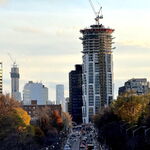Slightly off topic, but I'm starting to think that the new fleet is going to have worse legroom than the current fleet. Here's the math:
9100 passengers/32 trainsets/4 cars = 71.9 passengers per car
That equals to at least another row of seats when compared to the LRCs which have 68 seats per car (Brightline has 64 seats per car). This also doesn't take into account the fact that business class is going to be in a less dense configuration which could add another row or two into economy class. If the 9100 passengers number remains correct, the seats are probably going to be a tight squeeze.




